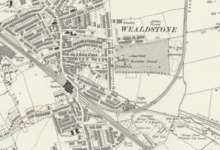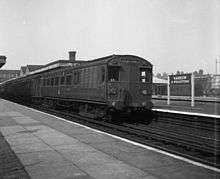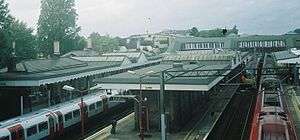Harrow & Wealdstone station
| Harrow & Wealdstone | |
|---|---|
 | |
 Harrow & Wealdstone Location of Harrow & Wealdstone in Greater London | |
| Location | Wealdstone |
| Local authority | London Borough of Harrow |
| Managed by | London Underground[1] |
| Owner | Network Rail |
| Station code | HRW |
| DfT category | C1 |
| Number of platforms | 6 |
| Accessible | Yes [2] |
| Fare zone | 5 |
| London Underground annual entry and exit | |
| 2009 |
|
| 2012 |
|
| 2013 |
|
| 2014 |
|
| 2015 |
|
| National Rail annual entry and exit | |
| 2009–10 |
|
| 2010–11 |
|
| 2011–12 |
|
| 2012–13 |
|
| 2013–14 |
|
| Key dates | |
| 1837 | Opened (L&BR) |
| 1890 | Opened Stanmore Branch Line (L&NwR) |
| 1917 | Started (Bakerloo line) |
| 1952 | Train crash |
| 1964 | Closed Stanmore Branch Line (BR) |
| 1982 | Ended (Bakerloo line) |
| 1984 | Restarted as terminus (Bakerloo line) |
| Listed status | |
| Listed feature |
East side/bridge West side/platforms |
| Listing grade | II |
| Entry number |
1253982[5] 1253986[6] |
| Added to list |
6 September 1989 13 July 1990 |
| Other information | |
| Lists of stations | |
| External links | |
| WGS84 | 51°35′33″N 0°20′08″W / 51.5925°N 0.3355°WCoordinates: 51°35′33″N 0°20′08″W / 51.5925°N 0.3355°W |
|
| |
Harrow & Wealdstone is a interchange station in Wealdstone in the London Borough of Harrow, Greater London. It is served by London Overground, London Midland, Southern and London Underground services. The station is located between The Bridge, Wealdstone, (which joins the southern end of High Street) and Sandridge Close, Harrow with entrances leading to both.
The Harrow and Wealdstone rail crash of 1952, killing 112 people, occurred at the station. It remains Britain's worst peacetime rail disaster.
History

The station was opened by the London and Birmingham Railway (L&BR) as Harrow on 20 July 1837 in what was then rural Middlesex.[7] At the time the station was built, the area was fields and the nearest large settlement was at Harrow on the Hill about 1.5 miles (2.4 km) to the south. Wealdstone was a collection of houses at the north end of what is now Wealdstone High Street, about 1 mile (1.6 km) north of the station. The station buildings on the south west (Harrow) side of the station are the older part of the station, located beside what were the fast lines until the platforms were used for the later Euston to Watford DC Line and the main line tracks were re-routed through the previous slow line platforms and new platforms (numbers 5 and 6) to the north east; a new, larger, station building was also erected on this Wealdstone side of the station. The station footbridge was originally constructed with a full-height central barrier with passengers using the "London" side and railway and postal staff using the "country" side to move goods and mail via lifts which were removed in the early 1970s, leaving two parcels elevators serving the DC line platforms for the remaining postal traffic.
On 18 December 1890, a short branch line was opened by the London & North Western Railway (LNWR, successor to the L&BR) to Stanmore to the north-east of the main line. In 1932 an intermediate halt was constructed as Belmont to serve the developing residential areas locally. The train was known affectionately as the "Belmont Rattler".
By the end of the 19th century Wealdstone had developed in size and the station was given its current name on 1 May 1897 to reflect more accurately its location.[7]
On 16 April 1917, Bakerloo line services were extended from Willesden Junction to Watford Junction running on the newly electrified local tracks (the "New Lines", which were originally steam-worked) and calling at Harrow & Wealdstone from that date.[8]
On 15 September 1952, the passenger service to Stanmore - by then renamed Stanmore Village to avoid confusion with the Metropolitan Railway's (later Bakerloo, and now Jubilee) station opened in 1934 - was withdrawn. Freight traffic (particularly the storage of bananas) continued sporadically until about 1965.

During the early 1960s, as part of the West Coast Main Line electrification, the bridge carrying the A409 road (The Bridge/Station Approach) over the railway was rebuilt easing the previous severe road gradients and offering higher clearance over the tracks to allow for overhead catenary cabling.
On 5 October 1964, all services on the branch line to Belmont were withdrawn as part of the cuts of the Beeching Axe. The permanent way north of Harrow and Wealdstone station was removed but the disused platform 7 on the eastern side of the station was left in place as a siding for a further few years until it too was removed.
On 24 September 1982, Bakerloo line services to Harrow & Wealdstone ended when services north of Stonebridge Park were ended.[8] However the closure was short-lived, and the Bakerloo line to Harrow & Wealdstone was reinstated on 4 June 1984 with the station acting as the terminus.[8]
In the 1990s major reconstruction of local roads made to by-pass High Street, Wealdstone sent a new road (Ellen Webb Drive) through what remained of the station goods yard and part of the forecourt of the eastern entrance (1917) to the station.
Accidents and incidents
- On 7 August 1838 Thomas Port was fatally injured when he fell from a train and was run over about 1.25 miles (2.01 km) south of the station.
- In 1870, a mail train was in a rear-end collision with a freight train. Eight people were killed.[9]
- On 8 October 1952, the station witnessed Britain's worst train crash in peacetime when 112 people were killed and 340 were injured as a result of a Scottish express train colliding with the rear of a local train standing at platform 4. Seconds later a northbound express hauled by two locomotives collided with the wreckage causing further injury and demolished one span of the footbridge and the northern end of platforms 2 and 3. A memorial plaque was placed above the main entrance on the eastern side of the station to mark the 50th anniversary in 2002.
The station today

The station has undergone several improvements in recent years, with the footbridge (which links both entrances and all platforms) improved by removal of the central barrier to allow use of the full width, new lifts for the use of disabled persons, and newly painted and brightly illuminated waiting rooms. In recent years the two-track reversing sidings (used for turning Bakerloo line trains and occasionally for DC line trains) located between the tracks of the DC line at the northern end side of the station have been replaced by a single siding and the curve at the Down end of platform 2 eased using the space vacated by the removed siding; this in practice leaves the siding unavailable for use by LO trains except when Bakerloo trains are not running. Harrow and Wealdstone (with Willesden Junction) is one of the two stations on the DC line which can be used for turning or stabling trains clear of the running lines during reduced or disrupted services although trains can be reversed using crossovers at more stations.
Ticket gatelines have been installed at both entrances in addition to the pre-existing booking offices
Trains on the Fast lines pass this station through platforms 3 and 4, usually without serving this station; access to these platforms is now by staff-operated gates which are opened when necessary. Southern and London Midland stopping services generally use platforms 5 and 6 on the Slow lines but all can use either pair of platforms when needed since the four Main Line platforms were lengthened to take 12-coach trains. Platform 2 on the Up DC line has unusually been maintained at a length of 182m[10] rather than the usual DC line length of around 125m, long enough for an 8-coach train; on rare past occasions in recent years involving total closure of the Fast and Slow lines, main line trains have been diverted over the DC line between Watford Junction and Euston but without stopping at intermediate stations.
Crossrail
Network Rail's July 2011 London & South East Route Utilisation Strategy (RUS) recommended diverting West Coast Main Line (WCML) services from stations between London and Milton Keynes Central away from Euston, to Crossrail via Old Oak Common, to free up capacity at Euston for High Speed 2. This would provide a direct service from the WCML to the Shenfield, Canary Wharf and Abbey Wood, release London Underground capacity at Euston, make better use of Crossrail's capacity west of Paddington, and improve access to Heathrow Airport from the north.[11] Under this scheme, all Crossrail trains would continue west of Paddington, instead of some of them terminating there. They would serve Heathrow Airport (10 tph), stations to Maidenhead and Reading (6 tph), and stations to Milton Keynes Central (8 tph).[12]
In August 2014, a statement by the transport secretary Patrick McLoughlin indicated that the government was actively evaluating the extension of Crossrail as far as Tring, with potential Crossrail stops at Harrow & Wealdstone, Watford Junction, Hemel Hempstead, Berkhamsted and Tring. The extension would relieve some pressure from London Underground and London Euston station while also increasing connectivity. Conditions to the extension are that any extra services would not affect the planned service pattern for confirmed routes, as well as affordability.[13][14]
Service patterns
from 13 December 2009
Main Line services
As of December 2015 the typical Monday-Saturday service is:[15]
- 2tph to London Euston (London Midland).
- 1tph to East Croydon (Southern).
- 2tph to Tring (London Midland)
- 1tph to Milton Keynes Central (Southern).
Local services (DC line)
Typical Monday-Saturday frequencies in November 2015[16]
- 3tph to London Euston (London Overground)
- 6tph to Elephant & Castle (London Underground)
- 3tph to Watford Junction (London Overground)
Connections
London Buses routes 140, 182, 186, 258, 340, H9 and H10 and night route N18 serve the station.
Access to Station
The TfL Getting Around map shows this station as having disabled access (platform 1 does not involve the use of a lift when entering/leaving the Harrow entrance nor does platform 6 using the Wealdstone entrance).
References
- ↑ "Safety boost as London Underground to take control of 11 Silverlink stations". Transport for London. 5 December 2006. Archived from the original on 13 December 2014. Retrieved 19 February 2015.
- ↑ "Step free Tube Guide" (PDF). Transport for London. Archived (PDF) from the original on 3 June 2015.
- 1 2 3 4 5 "Multi-year station entry-and-exit figures" (XLS). London Underground station passenger usage data. Transport for London. April 2016. Retrieved 3 May 2016.
- 1 2 3 4 5 "Station usage estimates". Rail statistics. Office of Rail Regulation. Please note: Some methodology may vary year on year.
- ↑ Historic England. "Details from listed building database (1253982)". National Heritage List for England. Retrieved 14 November 2012.
- ↑ Historic England. "Details from listed building database (1253986)". National Heritage List for England. Retrieved 14 November 2012.
- 1 2 Harris, Cyril M. (2006) [1977]. What's in a name?. Capital Transport. p. 33. ISBN 1-85414-241-0.
- 1 2 3 Rose, Douglas (1999). The London Underground, A Diagrammatic History. Douglas Rose/Capital Transport. ISBN 1-85414-219-4.
- ↑ Hall, Stanley (1990). The Railway Detectives. London: Ian Allan. p. 40. ISBN 0 7110 1929 0.
- ↑ Network Rail - LNW South Route Sectional Appendix
- ↑ Rail Utilisation Strategy, 2011, pp. 150.
- ↑ "'Emerging scenario' suggests Crossrail to the West Coast Main Line". Rail. Peterborough. 10 August 2011. p. 8.
- ↑ "Crossrail extension to Hertfordshire being considered". BBC News. 7 August 2014. Retrieved 7 August 2014.
- ↑ Topham, Gwyn (7 August 2014). "New Crossrail route mooted from Hertfordshire into London". The Guardian. Retrieved 12 August 2014.
- ↑ GB eNRT December 2015 Edition, Tables 66 & 176 (Network Rail)
- ↑ GB eNRT December 2015 Edition, Table 60 (Network Rail)
External links
| Wikimedia Commons has media related to Harrow & Wealdstone station. |
- Train times and station information for Harrow & Wealdstone station from National Rail
- London Transport Museum Photographic Archive
- Europe's history of rail disasters (BBC)
- Harrow and Wealdstone Disaster
| Preceding station | Following station | |||
|---|---|---|---|---|
| Terminus | Bakerloo line | towards Elephant & Castle |
||
towards Watford Junction | Watford DC Line | towards Euston |
||
| |
||||
| Watford Junction | Southern West London Route |
Wembley Central | ||
| Bushey or Watford Junction |
London Midland West Coast Main Line |
London Euston or Wembley Central | ||
| Historical railways | ||||
towards Watford Junction | Bakerloo line | towards Elephant & Castle |
||
| Disused railways | ||||
| Terminus | British Railways Stanmore Branch Line |
Belmont | ||
